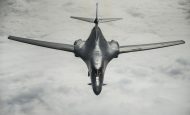
BARKSDALE AIR FORCE BASE: Over the last 35 years, the B-1B Lancer community has continuously reinvented itself as a premiere long-range precision strike platform. However, continuous bomber support operations over the last 20 years have taken a toll on the airframe’s structure due to overuse in a manner not commensurate with its planned design.
Currently a portion of the B-1Bs are in a state that will require tens of millions of dollars per aircraft to get back to a status quo fleet in the short term until the B-21 Raider comes online. As such, Air Force officials proposed the retirement of 17 structurally deficient B-1Bs in 2021 so that maintenance dollars and manpower can be focused on the healthiest aircraft in the fleet.
In addition, in coordination with our contractors, the Program Office, Combatant Command planners and our most advanced weapons’ school Airmen, the Air Force has changed various flight employment tactics of the remaining B-1Bs to preserve the longevity of the aircraft. These changes will significantly extend the life of the B-1B and reduce costs associated with potential structural repairs during the transition to the B-21.
The Air Force is not planning to close any B-1B squadrons, reduce major manpower pools or close any bomber bases. The reduction of B-1s from Ellsworth and Dyess Air Force Bases will be spread across both units.
In addition, the Air Force will maintain adequate B-1B capability through a heavy B-52 test period and initial B-21 buildup. This is the start of the B-1B retirement which has been planned for some time, but sped up on the most deficient aircraft in the fleet.
With the 2021 budget rollout, major modernization programs within AFGSC continue to be funded.
- B-21 funding remains on track.
- The Ground Based Strategic Deterrent program will ramp-up funding to execute the first full fiscal year of the engineering and manufacturing development contract and advance major activities, including: systems engineering, information technology, data management and analytical capabilities.
- The B-52 is executing a comprehensive modernization, to include increased weapons capacity, upgrades to communication systems, and replacement of engines and radar system; funding to integrate Advanced Extremely High Frequency capability, which provides survivable, high bandwidth, and secure two-way command and control communications. Radar modernization and engine replacement are the two largest programs.
- The Air Force continues to execute a comprehensive B-2 modernization and sustainment program including armament upgrades, communications upgrades, and low-observable signature and supportability modifications and is committed to keeping the B-2 viable, sustainable and affordable until B-21 is operational.
- The FY21 PB fully funds the Long Range Stand Off weapon developmental program. LRSO is currently on track and has the same five-year profile as it did in last year’s budget.
- The funding profile for the B-61 remains the same as last year.
Maintaining the credibility and readiness of our strategic capabilities requires a long-term, visible commitment to sustainment and modernization. Air Force Global Strike Command continues to work within National Defense Strategy guidance, which sets the course for the Department of Defense for the coming years. The NDS provides clear guidance on how we will prioritize our efforts and resources to preserve maximum advantage against those who seek to threaten the security and prosperity of America or our allies and partners.
Click here for original story, USAF Global Strike proposes retiring 17 B-1s, major modernization programs on track
Source: Air Force News